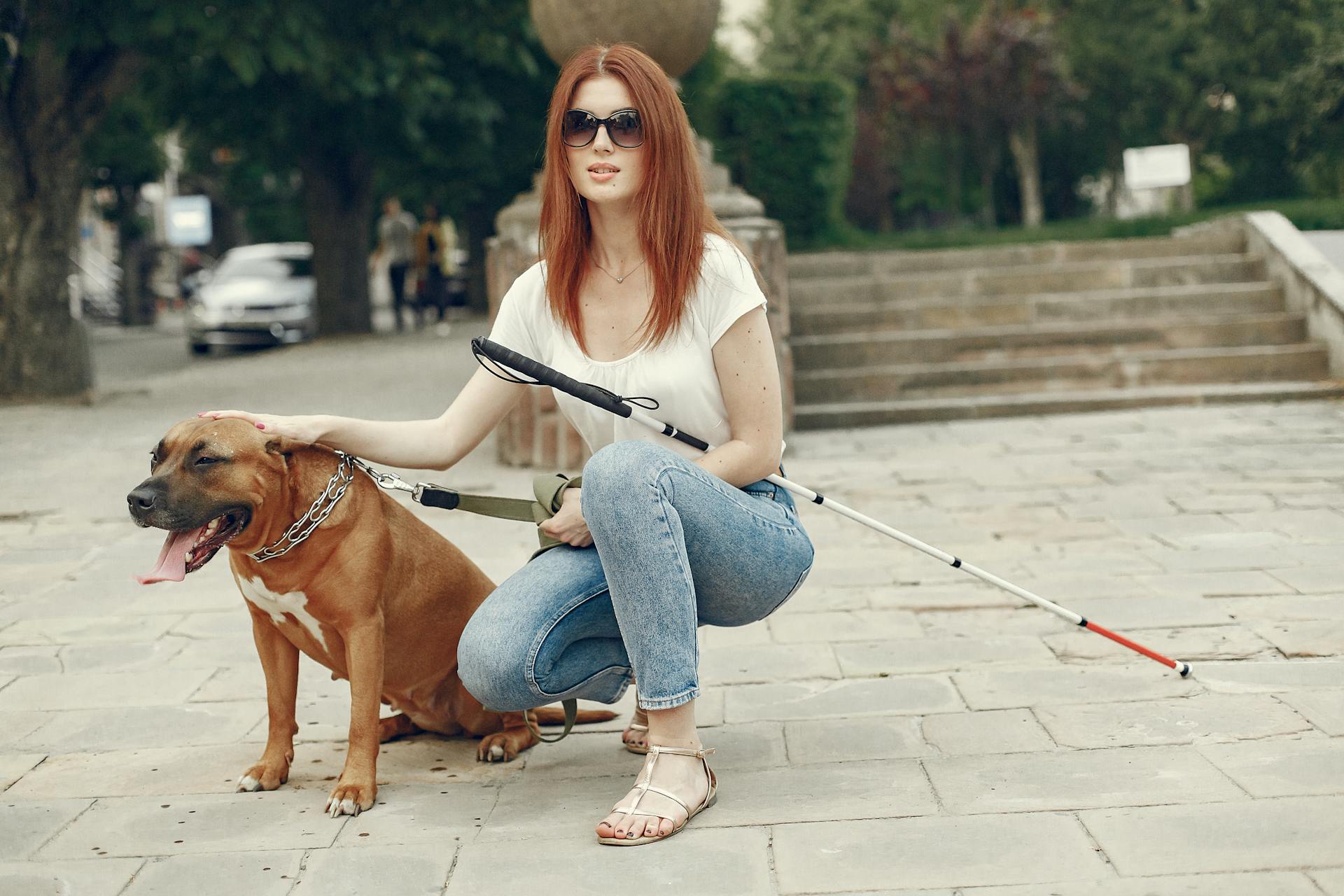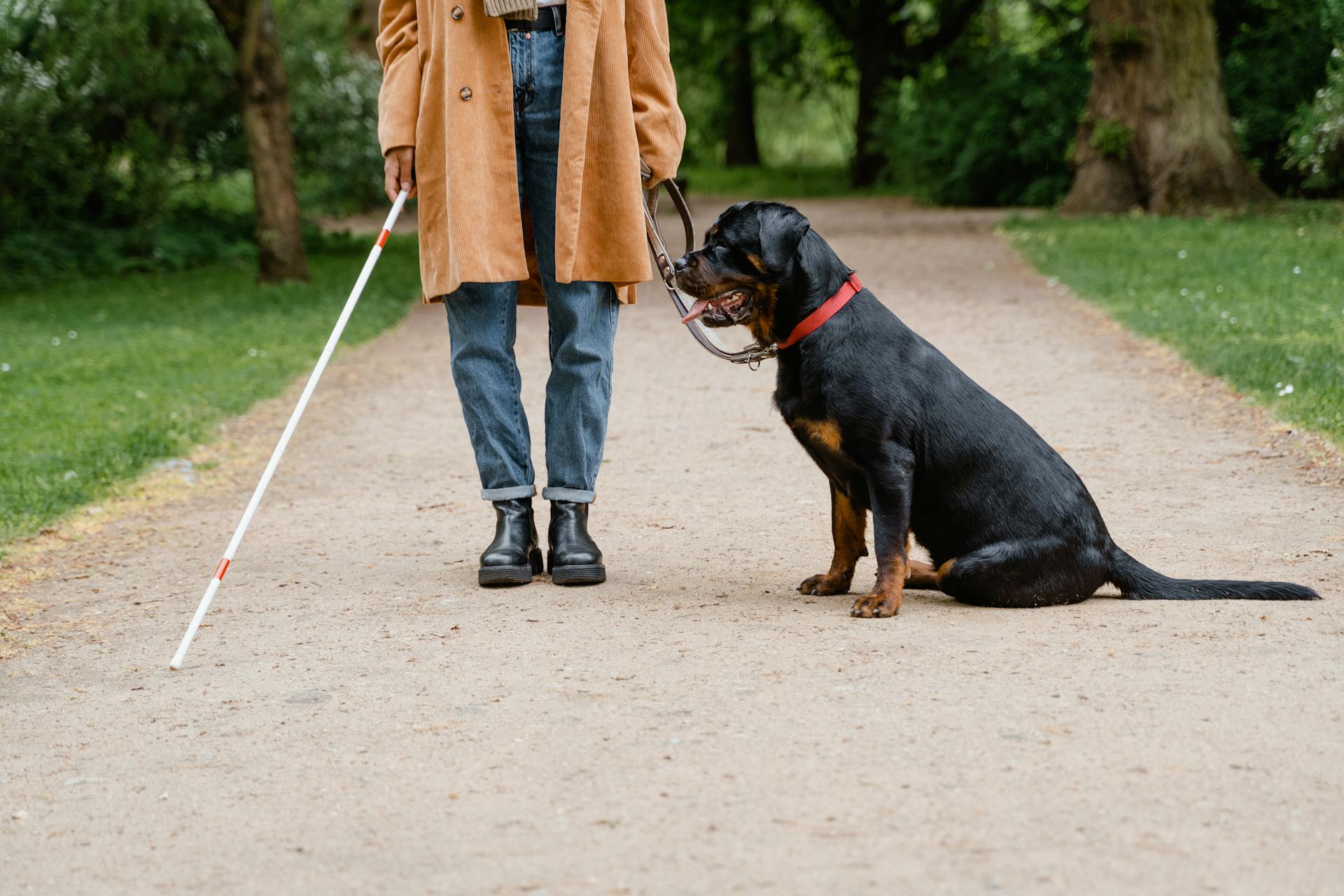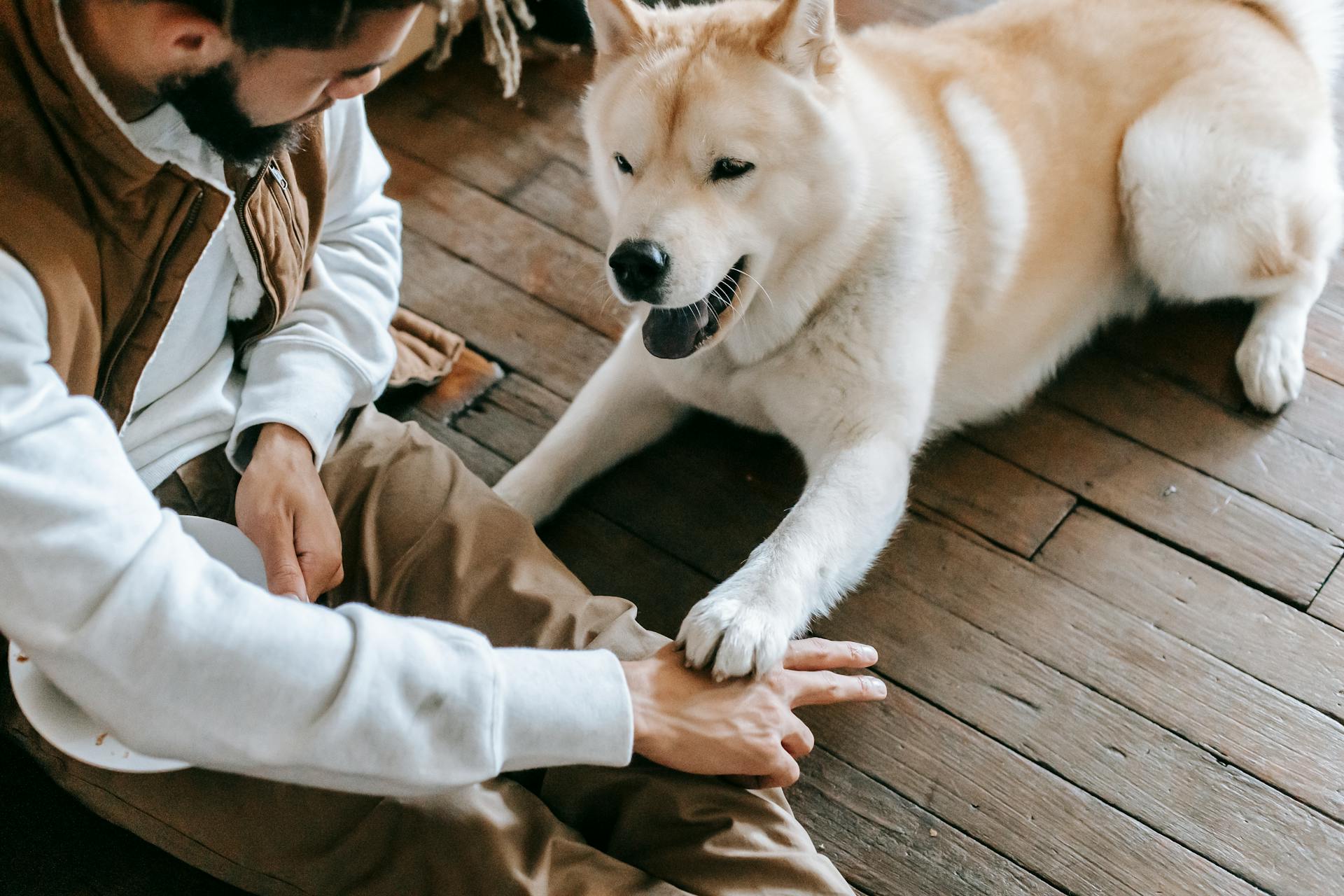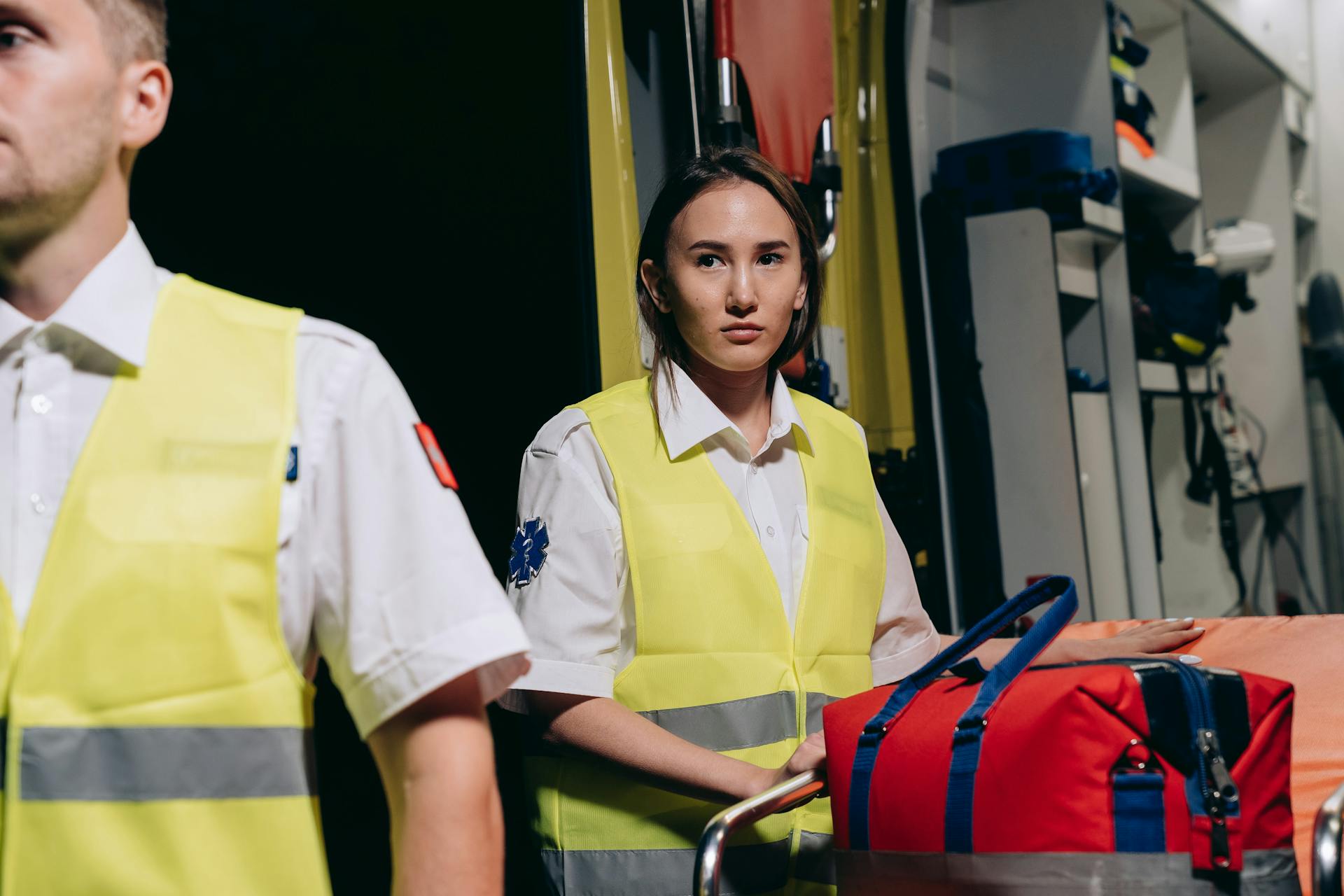
Assistance dogs are trained to perform specific tasks to help individuals with disabilities, and their training is a remarkable process. They can be trained to assist people with physical disabilities, mental health conditions, and even medical conditions like diabetes.
One of the key characteristics of assistance dogs is their ability to remain calm in public, which is essential for their work. This is achieved through extensive socialization and training.
Assistance dogs can be trained to perform a wide range of tasks, from opening doors to providing emotional support. Their training is tailored to meet the specific needs of their handler.
A well-trained assistance dog can make a huge difference in the life of their handler, providing independence and confidence.
Readers also liked: Mental Illness Service Dogs
What is an Assistance Dog
An assistance dog is not just any dog, but a highly trained animal that performs a specific job or task for a person with a disability.
The Americans with Disabilities Act (ADA) makes a distinction between psychiatric service dogs and emotional support animals. Service dogs are trained to perform a specific job or task, such as sensing an anxiety attack and taking action to help avoid it.
Service dogs are not required to wear vests or display identification, but they can wear special harnesses, collars, or tags if their owners choose to do so. Many dogs that wear ID vests or tags are not actual service dogs, however.
To qualify as a service dog, the dog must be trained to perform a specific job or task, not just provide comfort by being present. For example, a dog that has been trained to sense an anxiety attack and take action to help avoid it is a service dog, but a dog that provides comfort just by being present is not.
Service dogs have access to public facilities under the ADA, but emotional support animals do not. However, some state and local governments have enacted laws that allow owners to take emotional support animals into public places.
Consider reading: Is a Public Access Test Required for Service Dogs
Tasks and Responsibilities
A service dog's tasks can be tailored to their handler's specific needs, such as retrieving objects or reminding them to take medication.
Their tasks are designed to assist with daily life, making it easier for people with disabilities to navigate the world.
A service dog may be trained to detect the onset of a seizure and help their handler remain safe during the episode.
To train a service dog, it's essential to focus on foundation skills like house training and socialization.
The AKC Canine Good Citizen program provides guidelines and benchmarks for foundation skills, while the "Confident Puppy" e-learning course offers puppy raising skills for working dogs.
A service dog must be trained to perform work or specific tasks to assist with a disability, such as pressing buttons on doors or serving as a brace.
Their tasks can include fetching medication, providing bracing, and bringing a telephone to their handler if required.
Classification and Types
Assistance dogs are highly trained to perform specific tasks for individuals with disabilities. They are classified into different types based on their functions.
Common examples of assistance dogs include guide dogs, hearing dogs, mobility assistance dogs, medical response dogs, seizure response dogs, psychiatric service dogs, and autism assistance dogs. Each of these types of dogs is trained to assist people with specific needs.
Under the Americans with Disability Act, there is no formal certification or registration required for a dog to become an assistance dog. This means that any dog can be trained to be an assistance dog, as long as it is trained to perform specific tasks.
Here are some common types of assistance dogs:
- Guide dogs
- Hearing dogs
- Mobility assistance dogs
- Medical response dogs
- Seizure response dogs
- Psychiatric service dogs
- Autism Assistance dogs
The 10 Types
There are many types of service dogs, each trained to perform specific tasks to help their owners with various disabilities. Guide dogs are one of the most commonly known types, assisting the blind and visually impaired.
Guide dogs are trained to navigate through the world and are equipped with a special harness that allows their handler to grasp them. They practice "selective disobedience", meaning they take in information from their surroundings and make choices based on the assessments made about a situation.
Additional reading: Types of Hunting Hounds

Some of the best breeds for guide dogs include Labradors, Golden Retrievers, and Standard Poodles. These breeds are often chosen for their intelligence, loyalty, and strong sense of smell.
Hearing dogs are trained to help their deaf or hard-of-hearing owners interact with their world. They can alert their owner about smoke alarms, doorbells, stove timers, and even crying babies.
The best breeds for hearing dogs include Labradors, Cocker Spaniels, Miniature Poodles, and Cockapoos. These breeds are often chosen for their ability to detect and respond to sounds.
Seizure response and alert dogs are trained to respond before, during, and after their handler has a seizure. An alert dog is trained to detect seizures before they happen, while their response counterparts are trained to react during and after the seizure.
Some of the best breeds for seizure response and alert dogs include Labradors, Golden Retrievers, Poodles, German Shepherds, and Collies. These breeds are often chosen for their intelligence and strong sense of smell.
Diabetic alert dogs are trained to detect potentially deadly changes in blood sugar levels during hypoglycemic or hyperglycemic events. They can then warn their handler of these changes so they can address them appropriately before they get out of hand.
Expand your knowledge: Powerful Male Names Dogs

The best breeds for diabetic alert dogs include Golden Retrievers, Labradors, Mixed-Sporting Breeds, Poodles, and Collies. These breeds are often chosen for their ability to detect subtle changes in their owner's body chemistry.
Mobility assistance dogs are trained to help their owners with physical disabilities, such as paralysis or multiple sclerosis. They can be trained to pull a wheelchair, open doors, and even pick up items.
The best breeds for mobility assistance dogs include larger breeds like Great Danes, Saint Bernards, and Bernese Mountain Dogs. These breeds are often chosen for their strength and size.
Autism assistance dogs are trained to help their owners with autism spectrum disorder. They can be trained to provide emotional support, interrupt self-destructive behaviors, and even provide physical support.
The best breeds for autism assistance dogs include Labradors, Golden Retrievers, and Poodles. These breeds are often chosen for their intelligence and strong sense of loyalty.
Medical response dogs are trained to provide medical assistance in emergency situations. They can be trained to call 911, provide first aid, and even administer medication.
The best breeds for medical response dogs include Labradors, Golden Retrievers, and Poodles. These breeds are often chosen for their intelligence and strong sense of loyalty.
You might enjoy: Medical Alert Dog Training

Psychiatric service dogs are trained to help their owners with mental health conditions, such as post-traumatic stress disorder (PTSD) or depression. They can be trained to provide emotional support, interrupt self-destructive behaviors, and even provide physical support.
The best breeds for psychiatric service dogs include Labradors, Golden Retrievers, and Poodles. These breeds are often chosen for their intelligence and strong sense of loyalty.
Here are the 10 types of service dogs, each with their unique function and breed characteristics:
Autism
Autism Assistance Dogs are trained to assist adults and children on the autism spectrum. They can provide invaluable physical, mental, and emotional support to the person they're meant to help.
These dogs can perform actions such as interrupting self-harming behaviors, providing a counterbalance for those with poor motor control, assisting with disorientation, assisting with self-soothing during meltdowns, and preventing wandering.
Autism Assistance Dogs are trained to assist individuals with autism to live independently and manage their disability. They can make a huge difference in the lives of those with autism.
Suggestion: Autism Assistance Dog
Some of the best breeds for Autism Assistance Dogs include Labradors, Poodles, Newfoundlands, Bernese Mountain Dogs, and Beagles.
Here are some examples of the tasks Autism Assistance Dogs can perform:
Frequently Asked Questions
Can someone ask me for papers on my service dog?
No, you cannot ask for papers or documentation on a service dog. Service animals are protected under law, and inquiring about registration or certification is not allowed.
What is the most common breed of assistance dog?
Labradors and Golden Retrievers are the most common breeds used as assistance dogs due to their intelligence, trainability, and gentle nature. They're often preferred for roles that require a calm and non-threatening presence.
Featured Images: pexels.com


